Digital Poster
Neurofluids: Physiology
ISMRM & ISMRT Annual Meeting & Exhibition • 10-15 May 2025 • Honolulu, Hawai'i

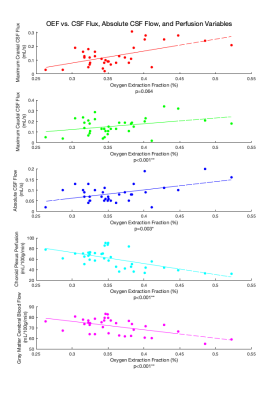 |
Computer Number: 129
4555. An
MRI investigation of the diurnal relationship between cerebral
hemo-metabolic activity and bulk cerebrospinal fluid flux
M. Curtin, A. Dubois, M. Leguizamon, A. Song, K. Hett, C.
Considine, M. Garza, M. Donahue
Vanderbilt University Medical Center, Nashville, United States
Impact: Concurrent measures of cerebral perfusion,
oxygen extraction fraction, and CSF flow performed at
different times of day can be used to help inform how
ongoing, endogenous hemo-metabolic tone may regulate
neurofluid circulation.
|
|
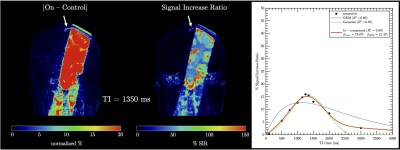 |
Computer Number: 130
4556. Modeling
CSF Outflow: A Bi-Component Approach with Time-SLIP MRI
V. Malis, M. Miyazaki
UC San Diego, San Diego, United States
Impact: The bi-component model provides a more accurate
characterization of CSF outflow dynamics, distinguishing
fast and slow flow components. It offers potential for
future studies on age-related changes in CSF outflow, aiding
in early biomarkers in neurodegenerative disease research.
|
|
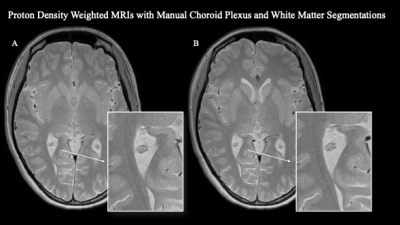 |
Computer Number: 131
4557. The
Choroid Plexus Water Density in Humans Assessed from
High-Spatial Resolution Proton Density MRI: Normative Values and
Effect of Time of Day
A. Dubois, M. Curtin, A. Song, M. Leguizamon, M. Garza, K.
Hett, C. McKnight, C. Considine, M. Donahue
Vanderbilt University Medical Center, Nashville, United States
Impact: Determining choroid plexus (ChP) water density
will provide a method for accurate calculation of ChP
perfusion, leading to an improved physiological
understanding of the role of the ChP as the most proximal
component of the neurofluid circuit.
|
|
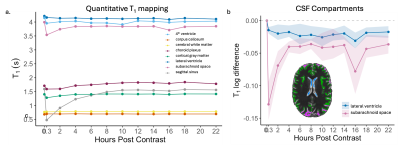 |
Computer Number: 132
4558. Quantitative
IV Contrast-Enhanced MRI Measures Blood-to-CSF Exchange in the
Human Brain over 24 Hours
B. Meyer, L. Ray, T. Pedersen, J. Reusch, D. Kernagis, J.
Illif, S. Rane Levendovszky
University of Washington, Seattle, United States
Impact: Intravenous contrast leakage into CSF spaces was
measured with quantitative and qualitative MRI, advancing
methods to assess blood-to-CSF exchange. Contrast appeared
within 1 hour and persisted for several hours, with
potential leakage routes identified.
|
|
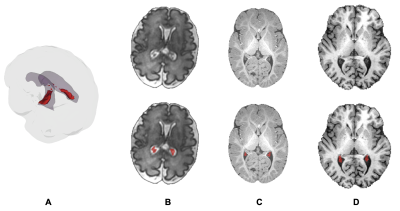 |
Computer Number: 133
4559. Choroid
Plexus Volume across the Lifespan
J. Li, Y. Gao, Y. Hu, X. Feng, L. Zhao
Zhejiang University, Hangzhou, China
Impact: This study provided a baseline of ChP in
lifespan, which may promote the understanding of its
function throughout brain development stages and provide
reference values for aging-related research.
|
|
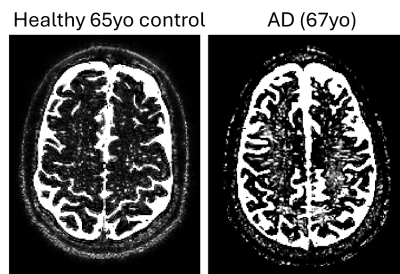 |
Computer Number: 134
4560. High-resolution
practical imaging of perivascular spaces
M. Taso, C. Brown, I. Nasrallah, D. Wolk, J. Detre
Siemens Medical Solutions USA Inc, Malvern, United States
Impact: This work demonstrates that perivascular spaces
can be imaged in a clinically compatible time across
field-strengths. Pilot scans in AD patients show widespread
increased signal, suggesting a potential interest in
specifically studying PVS in AD.
|
|
 |
Computer Number: 135
4561. A
Unique Perfusion-Mechanics Relationship in the Hippocampus
C. Neher, E. Triolo, O. Khegai, P. Balchandani, M. Kurt
University of Washington, Seattle, United States
Impact: Given that the hippocampus is exceptionally
vulnerable, with perfusion deficits often seen in diseases
related to learning and memory, our results suggest a
mechanistic link between metabolic health and stiffness
biomarkers in this key region for the first time.
|
|
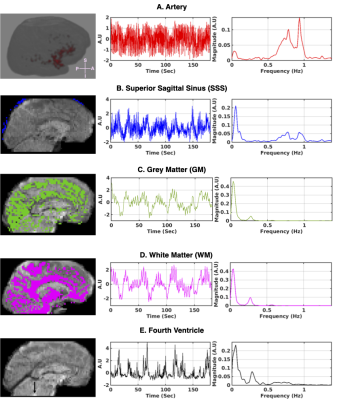 |
Computer Number: 136
4562. Impact
of Drowsiness on Low-Frequency, Respiratory, and Cardiac
Oscillations across Neurofluid Compartments

V. V Nair, A. M Wright, T. Xu, E. Foster, X. Zhou, Y.
Tong, Q. Wen
Indiana University School of Medicine, Indianapolis, United States
Impact: These findings demonstrate regional variability
in LFO across neurofluid compartments and reveal a
consistent increase during drowsiness, suggesting its
potential role in driving glymphatic movement, particularly
in sleep.
|
|
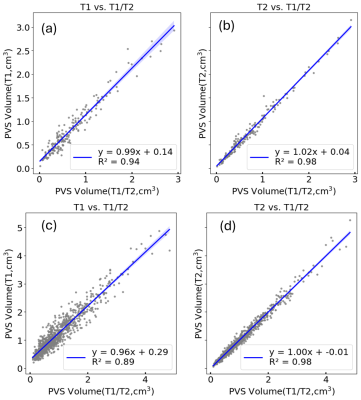 |
Computer Number: 137
4563. Comparative
Assessment of T1w, T2w, and Combined T1w/T2w MRI Images for
Perivascular Space Measurement
R. Song, R. Raja, W. Reddick
St Jude Children's Research Hospital, Memphis, United States
Impact: T1w and T2w methods are precise and highly
correlated with preferred combined 3D T1w/T2w method for
measuring perivascular spaces (PVS) suggesting that clinical
MRI protocols with T1w or T2w imaging can have broader
applications in neurological research for PVS assessment.
|
|
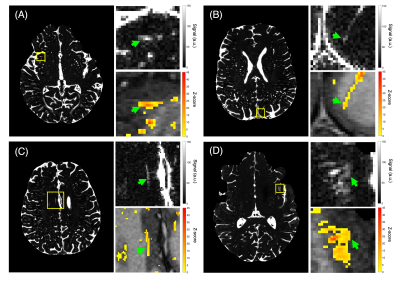 |
Computer Number: 138
4564. Detection
of Cortical Perivascular Spaces using Heavily T2-weighted MRI at
7T
G. Saib, Z. Demir, P. Taylor, S. Talagala, A. Koretsky
National Institute of Neurological Disorders and Stroke/NIH, Bethesda, United States
Impact: This study lays the groundwork for assessing the
diagnostic utility of detecting cortical PVS changes as well
as understanding the mechanisms for structural changes in
cortex due to neurological disorders.
|
|
 |
Computer Number: 139
4565. Standing
MR images based on the physiological changes due to postures
C. Oh, Y. S. Jo, Y. Ryu, Y. Han, K-N Kim, J-Y Chung
Gachon University Gil Medical Center, Incheon, Korea, Republic of
Impact: We conducted neuro MR imaging utilizing standing
MRI technology. We acquired T1-weighted and T2-weighted
images in two distinct postural positions. To facilitate a
comparative analysis of images acquired in different
postural positions, we performed registration by using
SPM12.
|
|
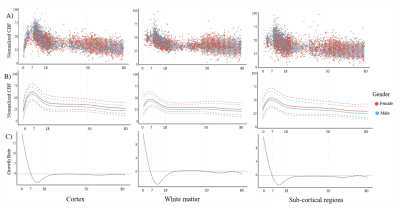 |
Computer Number: 140
4566. Normative
Cerebral Perfusion Across the Lifespan
X. Zeng, Y. Li, R. Lu, L. Franco, J. Detre, Z. Wang
university of maryland, Baltimore, United States
Impact: This study introduces lifespan charts for brain
perfusion, providing a benchmark for identifying individual
deviations across neurological and psychiatric conditions.
These charts enable more precise evaluations of CBF
atypicalities than previously possible, advancing the
understanding brain function in individual level.
|
|
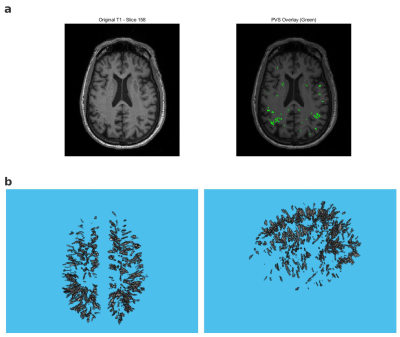 |
Computer Number: 141
4567. Associations
between perivascular space, arterial pulsation damping, and
cognitive impairment in elderly adults
Z. Wang, S. H. Chung, J. Tang, E. Joe, H. Chui, L. Yan
Northwestern University, Evanston, United States
Impact: Our findings indicate that impaired damping may
lead to transmitting executive pulsatile energy into the
brain and result in glymphatic system dysfunction with
enlarged PVS.
|
|
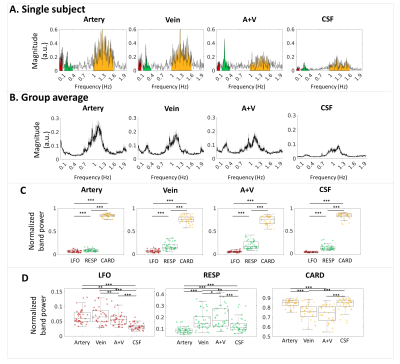 |
Computer Number: 142
4568. Quantitative
Evaluation of Low-Frequency Oscillation in Blood and CSF Flow
and its Changes from Eye Open to Eye Closed
H. Zhu, P. Liu, E. Foster, N. Jin, X. Zhou, O. Balédent, Q.
Wen
Indiana University School of Medicine, Indianapolis, United States
Impact: Cervical CSF flow shows LFO at 3%, below
respiration (13%) and cardiac (84%), contrasting with
LFO>cardiac at the fourth ventricle in fMRI. The consistent
LFO increase from alert to drowsy suggests a role in
enhancing fluid clearance during sleep.
|
|
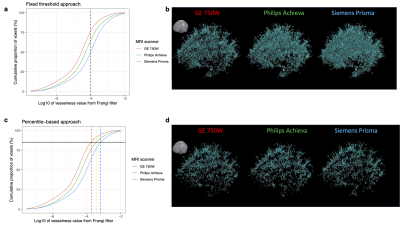 |
Computer Number: 143
4569. A
novel robust fully-automated approach to segment cerebral
perivascular spaces on clinical T1-weighted images
G. Barisano, M. Iv, J. Choupan, M. Hayden-Gephart
Stanford University, Stanford, United States
Impact: The simplicity and efficiency of our algorithm
in robustly and automatically assessing PVS on clinical MRI
facilitate its easy implementation in hospitals, clinical
trials, and even retrospectively for MRI data already
acquired, enabling multi-center, reproducible investigations
of human PVS.
|
The International Society for Magnetic Resonance in Medicine is accredited by the Accreditation Council for Continuing Medical Education to provide continuing medical education for physicians.